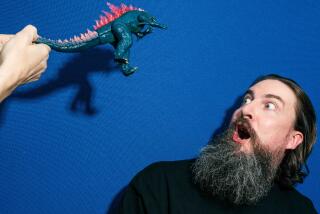Indie Focus: Quentin Dupieux knew ‘Rubber’ needed more than a killer tire
It would have once likely been called a “head” movie, something purposely strange, more than a little puzzling and perhaps more readily appreciated in some altered state of consciousness. Let’s face it: “Rubber,” written and directed by Frenchman Quentin Dupieux, better known to some as the electronic musician Mr. Oizo, is weird. Delightfully so.
Available on multiple video-on-demand platforms and opening in Los Angeles on April 1, “Rubber” is the story of a rubber tire that inexplicably gains consciousness. Moving about under its own power, it seems to stalk a young woman (Roxane Mesquida) across an existentially barren desert landscape in the American West. When it becomes upset, the tire begins to vibrate angrily and then other objects — including people’s heads — explode, as if by a psychic force exerted by the tire.
If that weren’t enough to intrigue audiences, the film has an entire other level of storytelling, in which a group of spectators in the desert have paid to watch the exploits of the tire. Much of the onscreen action of the movie — the girl and the tire — is from one angle just a show put on for the onscreen spectators, creating a complicated tension between the action, the onscreen audience and whoever is watching the film itself. Overall, the film plays a bit as though Steven Spielberg’s early truck-chase movie “Duel” had been directed by Luis Buñuel.
As Dupieux explained, the film’s promotional materials undersell the multi-level experience of watching the audience that is onscreen themselves watching the action, often commenting just as viewers in the theater might themselves be. Instead, selling the film has been focused on the essential hook of a psychic killer tire.
“We tried to explain the different layers, but it’s almost impossible,” said Dupieux recently in Los Angeles, where he is living. “So we decided to only communicate the basic idea — OK, it’s a movie about a killer tire. That’s exciting. And from this point, everything is possible.
“It’s quite hard to describe what the movie is about,” continued the 36-year-old Dupieux, who projects a Gallic combination of enthusiasm and aloofness. “If you say, OK, there are people watching the movie, and it’s a movie in the movie, and it’s not real, but it is, it’s very complicated.”
The film has its roots in the failure of Dupieux’s 2007 feature, “Steak,” an absurdist youth comedy. Frustrated that the film had no life outside of France, he decided to shoot something in English to give it a broader appeal. At first he wrote a script about cubes from space invading Earth.
After some tests with the CGI effects, he decided he didn’t like working in the empty studio spaces needed for the green-screen computer effects. Trying to come up with some sort of real object to focus on, he eventually rolled up to the idea of the tire.
“After writing maybe 20 pages of the tire story, I got bored,” said Dupieux of how the additional layers of story entered his script. “It just seemed like a murder movie, and instead of a shark or a psychopath, I had this tire. It’s a funny twist, nobody had done it before, but it wasn’t really enough. It was impossible to make something good with only this idea.
“So I needed to add another layer of reality, and I had the idea of people watching because my first movie was a flop, and I know that some theaters played the movie with nobody in the room. So putting spectators in the movie was a good way to have spectators, and to control them.”
Shot in the California desert using the Canon 5D still camera, the production had three tires to play the role of Robert, as the tire came to be called. One was remote controlled for some of the shots of the tire starting and stopping seemingly under its own power. At other times, a puppeteer controlled the tire from offscreen, and sometimes someone simply held onto a portion of the tire that was outside the camera’s frame. The low-tech effects are nevertheless remarkably effective for the way in which they keep viewers guessing from shot to shot how the Robert meets the road.
The film had its premiere as part of the prestigious Critics’ Week sidebar at last year’s Cannes Film Festival. Variety, capturing the befuddled tone of many early reviews, called the film a “cinematic non-sequitur.” In subsequent festival appearances at Austin, Texas’ Fantastic Fest and L.A.’s AFI Fest, the responses began to change as people started to better figure the film out.
The shifting, uncertain response to “Rubber” is not entirely a surprise, given that even people involved in its making are not entirely sure what it’s really about.
“I have no idea,” said French-born actress Roxane Mesquida, who plays the woman stalked by the tire, of what she thought the meaning of the movie was. Mesquida, who has appeared in three films for the French provocateur Catherine Breillat, was cast by Dupieux while she was already in California shooting a part in Gregg Araki’s “Kaboom.”
“To me, I think the tire is alive,” she added. “But it’s not like what’s true, what’s not true, what’s real and not real. It’s just like an experience, this weird feeling and interesting view on things. It doesn’t need an explanation.”
Though calling him a “visionary director,” as the film’s U.S. trailer does, feels as though it’s pushing it, with “Rubber” Quentin Dupieux has certainly declared himself an idiosyncratic talent capable of making a film genuinely like no other. “Rubber” is both super stupid and crazy smart.
“I hate movies that are only stupid, all the time, or only smart,” he said “I hate it. I like when everything is mixed together. Life is not only one thing. You can be happy but at the same time have strange feelings. It’s exactly what I’m trying to do, and I want to be very smart but very stupid. I want to be everything at the same time.”
More to Read
The biggest entertainment stories
Get our big stories about Hollywood, film, television, music, arts, culture and more right in your inbox as soon as they publish.
You may occasionally receive promotional content from the Los Angeles Times.







